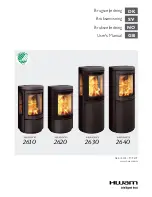
cod. 00 477 2250 - 11/2013 - PN - Italy
43/172
ENGLISH
INSTALLATION
5.4 FLUE GAS EXHAUST
The stove operates with negative pressure in the
w
gas discharge must be airtight.
The stove must be connected to its own separate
flue gas exhaust system capable of ensuring
adequate atmospheric dispersion of the combustion
byproducts.
'w
conditions and bear the CE mark.
'w
a nominal diameter of 8 cm with gaskets (up to 5
metres in length), or 10 cm with gaskets (for lengths
exceeding 5 metres) (Fig. 5.4.1).
'w!!
rock wool) or made using double wall steel pipes,
for all the chimney section inside the hood.
An initial vertical section measuring a minimum of
|!^ w
exhaust.
There should be at least three changes in direction
w w
at the rear of the stove, using 45 or 90° angle
connectors or ‘T’ connectors.
Use always a ‘T’ connector with inspection cap on
w!
The maximum length of horizontal sections is 2-3 m
with an upwards slope of 3-5% (Fig. 5.4.1).
#w!
'w@Y'=W'?&
connected to:
-
a chimney used by other heat generators
!!!!!
-
air exhaust systems (range hoods, vents,
etc.....) even if these are ducted.
Shut-off or draught valves must not be used.
Combustion byproducts must be discharged
through the roof.
* w ^
unsuitable discharge terminal, etc.) flue gas
exhaust may be less than optimum. In these cases,
w
w!
technical service for this procedure.
Fig. 5.4.1










































